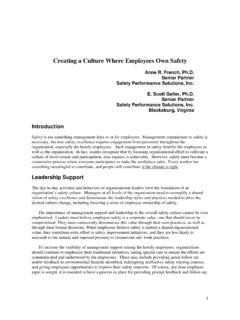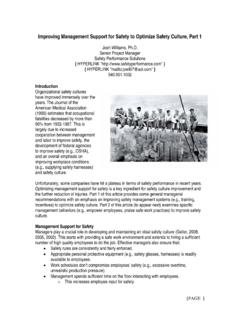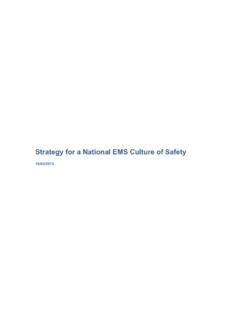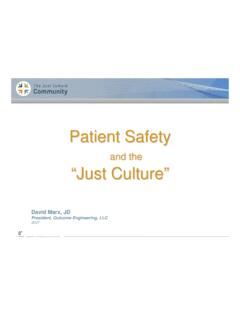Transcription of B-Safe
1 B-Safe ! "#Improving safety Culture: APractical Guideby Dominic CooperCopyright 2001 by Applied Behavioural SciencesHead office: 1060 Holderness Road, Hull, HU9 4 AHNational 01482 708899 International (+44) 1482 708899e-mail (for orders and customer service enquiries): our Home Page on published 1998 by John Wiley & Sons right of Dominic Cooper to be identified as Author of this work has been asserted by him in accordance with theCopyright, Designs and Patents Act Rights Reserved. No part of this publication may be reproduced, stored in a retrieval system, or transmitted, in anyform or by any means, electronic, mechanical, photocopying, recording, scanning or otherwise, except under the terms ofthe Copyright, Designs and Patents Act 1988 or under the terms of a license issued by the Copyright Licensing Agency,90 Tottenham Court Road, London, UK W1P 9HE, without the permission in writing of the of Congress Cataloging-in-Publication DataCooper, safety culture : a practical guide / Dominic 0-471-95821-2 (paper)1.
2 Industrial safety -Management. I. 08 -dc21 97 25693 CIPB ritish Library Cataloguing in Publication DataAcatalogue record for this book is available from the British LibraryISBN 1 901128 02 4 Typeset in Palatino & Skia by The Dzine Partnership, London: Concept of safety Culture1 Introduction1 The Evolution of the Concept of safety Culture3 Accident Causation Models5 Organisational Characteristics of a Good safety Culture13 Towards a Model of safety Culture14 How to Read This Book26 Summary27 Section One The Immediate Level of Effort292 Effective Leadership for Developing a safety Culture30 Introduction30 Leadership30 Strategic Planning32 Problem-solving37 Increasing People's Commitment to a Decision43 Strategic Communications51 Resistance to Change543 Methods of Evaluating and Integrating Organisational Systems60 Introduction60 Identifying structural problems61 Using Workflow Analysis to Identify Specific Information-sharing Problems62 Job Characteristics Analysis67 Work group Communications75 Job Analysis86 Work safety Analysis924 Developing Risk Control Systems94 Introduction94 What is Risk Assessment?
3 94 Risk Control Measures103 Section Two The Intermediate Level of Effort1115 Integrating Management Information Systems112 Introduction112 Management Control Mechanisms112 Information Requirements119 System Characteristics125 Developing an Integrated Management Information System1306 safety Management System Auditing144 Introduction144 Developing a safety Audit System144 Establishing the Need for safety Audits146 Types of safety Audit147 Audit Frequency150 Standards Required for Planning and Executing the Audit Programme153 Audit Elements157 Auditing Practice163 Audit Follow-up175 Reviewing the Audit System175 Section Three The Ultimate Level of Effort1777 safety Propaganda and safety Training178 Introduction178 safety Information Campaigns178 safety Training1828 Measuring safety Climate200 Introduction200 safety Attitudes200 safety Climate204 Developing a Survey Instrument2179 Improving Behavioural Safety225 Introduction225 Why Focus on Unsafe Behaviour?
4 226 Why do People Behave Unsafely?228 How is Unsafe Behaviour Prevented?230 Achieving Improvements in safety Behaviour233 Does it Work?233 Putting a Behavioural safety Initiative into Operation234 Additional Reading254 Index255 Contents In recent years companies have begun to recognise the important contribution that an effectivesafety culture can make to the control of their ongoing operational costs and the efficiency of theirongoing operations. Much of this is due to the recent introduction of EC goal-setting legislationthat places the onus on organisations to identify and properly manage the risks created by theiractivities. Many organisations have realised that this provides the perfect opportunity for them tostreamline their operational processes and optimise the associated management and controlsystems. In practice, it has also meant that responsibility for health, safety and environmentalissues has become firmly established as an integral part of the line management function, ratherthan being the sole domain of the safety officer (or safety department as has traditionally been thecase).
5 Therefore, now more than ever before, all levels of line management need to possess a muchgreater knowledge of how to develop and implement high quality safety management also need to know how to manage safety on a day to day basis throughout their areas traditional `policing' role of the safety practitioner has also changed. No longer a mere safetyofficer, the safety practitioner's role is now that of a high-level internal consultant. They areexpected to offer independent advice to senior management on the development of the organi-sation's safety policies and their short, medium and long term strategic objectives for creating andmaintaining a positive safety culture. In addition, they are expected to advise line-managers onboth the development and implementation of appropriate control and monitoring systems and thereview of ongoing safety performance, while at the same time conducting independent reviews ofthe whole safety management system.
6 To fulfil these functions in an effective manner, it is self-evident that safety practitioners must be authoritative all rounders. While possessing an awarenessof all aspects of safety per se, he or she will also need to: have an up-to-date and in-depth appreciation of all aspects of management and management systems be experienced in problem-solving and decision-making be highly aware of the effects organisational change and development issues ( project management, team-working, downsizing, contracting out, etc.) exert on when they are armed with all this knowledge will safety practitioners be in a position torecognise the need for change, and be able to positively influence unfolding events to help createan optimal safety culture throughout the organisation. Thus, because of their new consulting role,and the need to ensure that their recommendations accord with business needs, modern safetypractitioners must be as familiar with all aspects of management as those practitioners from otherdisciplines (such as finance, human resources, production, etc.)
7 Who comprise the seniormanagement team. Although the safety profession is making great strides to address these issues, it is still too often the case that many safety practitioners lack knowledge of the most basicmanagement tools and techniques and, therefore, lack an understanding of how they might beused to good is also true to say that many people who work in the field of safety do not really know what a` safety culture' is. Perhaps this is not surprising given that, with very few exceptions, many of uswho write or talk about safety culture tend to wave the phrase around like a well worn slogan thatis passed its sell-by date. Recent writings, for example, have berated successful real-life attempts toimprove safety , and have then gone on to say that what is needed is a ` safety Culture'. Not onlydoes this create the impression that a safety culture can be pulled out of thin air or poured from apacket of cornflakes, but it also creates obvious difficulties for busy managers have often asked of me `What doesan identifiable safety culture look like?
8 ' Myreplies used to paraphrase the working definition of safety culture written in the ACSNI report(published by the Health and safety Commission in 1993) by saying `that it is the product ofpeople's values and beliefs, their behaviour, and their commitment to your health and safetyprogrammes. This will be evident in people trusting what you have to say, sharing yourperceptions of the importance of safety , and having confidence in the effectiveness of your preven-tative measures'. After scratching their heads, they would reply, `Yes, but what doesan identifiablesafety culture look like?' This set me to thinking that, although those of us who write about safetyculture in the academic literature mightunderstand what we are all on about, the lay person doesnot. He or she needs much more concrete evidence than confusing academic definitions thatappear to lack substance. In essence, the lay person needs to be able to easily identify certaincharacteristics, the presence of which would indicate that the company has a good safety a three level strategy for developing a positive safety culture ( immediate,intermediate and ultimate) this book attempts to highlight some of the most important identifiablecharacteristics, while also providing the reader with the necessary tools to bring them `immediate' level of effort is concerned with developing strategic plans, converting these intoaction plans, and implementing these so that the organisation can fully integrate safety into all ofits systems.
9 The first pointer to look for is the quality of safety leadership demonstrated by theorganisation's chief executive officer (CEO) and senior management team. The presence ofmeasurable short, medium and long term strategic objectives to fully integrate safety into all of anorganisation's systems (including finance, human resources, marketing, legal, purchasing andsupply), which are known to all, demonstrates only one aspect of the required leadership. Theregular active monitoring and review of line management's implementation of these strategicplans by the senior management team demonstrates the most vital aspect of good safetyleadership. Without this, the possibility of creating a positive safety culture will become little morethan an illusion. Importantly, the findings of these reviews should be communicated to everyperson in the organisation on a regular basis. In other words it is not sufficient to develop strategicplans which are then left dormant.
10 They must be implemented, monitored and reviewed on aregular basis, with information about ongoing progress being made readily available to allemployees. Thus high quality, demonstrable safety leadership is an easily identifiable and Prefaceimportant indicator of a positive safety easily identifiable characteristic of a safety culture is the presence and quality of theorganisation's risk control systems. If risk assessments have been conducted on all the organi-sation's activities, and the appropriate control measures have been fully implemented, it isprobable that safety is being actively controlled at the operational level. However, the extent towhich risk assessments have been conducted can only be determined if such assessments and theappropriate control measures have been properly recorded. Thus, the presence and quality ofrecorded risk assessments that cover all of the organisation's activities provides a partial indicatorof a positive safety culture.








